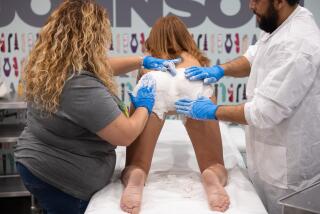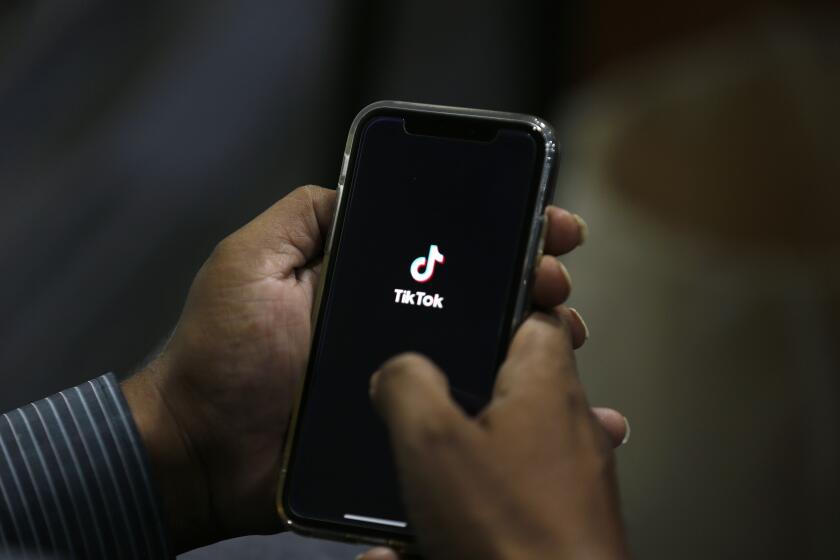Laser Sharp
- Share via
Even Wall Street types don’t hold back when Colette Cozean asks her stock question: “What is the first thing you think of when you think of dentists?”
“Pain!” they cry in unison.
The universality of the one-word response helps explain the explosion of attention that has come to Cozean in the weeks since the FDA approved her Irvine company’s innovation: a dental laser designed to treat tooth decay painlessly.
Talk about hitting people where it hurts.
“I think that’s one of the things that has made this such big news for people because they can identify,” says Cozean, 39, herself a former white-knuckler in the dentist’s chair.
The mission of her company--Premier Laser Systems Inc.--is no less than the overthrow of the traditional high-speed dental drill. Not only does the laser make a soft, barely perceptible sound--not unlike popcorn popping, Cozean says--but it virtually eliminates the need for an anesthetic.
Within days of the Food and Drug Administration’s May 7 announcement, the company’s stock price more than doubled and, for the first time since going public in 1995, Premier hit the top 10 in trading volume, far surpassing even giant Microsoft five days in a row.
Cozean was in New York meeting with a Wall Street analyst when the FDA issued its approval--a top agency official in Washington proclaiming the “use of lasers in dentistry is medicine for the 21st century.”
Within minutes of the midmorning announcement, the Manhattan office of Premier’s investor relations firm was inundated with requests for interviews with Cozean. Over the next 10 hours, Cozean did nearly 20 back-to-back interviews with TV, radio and print reporters.
In Irvine, all 20 of Premier’s phone lines were backed up throughout the day as hundreds of dentists around the country called to ask about or outright place an order for the $39,000 laser system.
That evening, the dental laser made all three network news broadcasts; the next morning it was in newspaper headlines across the country.
Cozean recalls phoning in from New York that first day for messages on her home answering machine. One of her favorites was from one of her son’s young friends, who said, “Mrs. Cozean, did you know you’re famous? I hope that even though you’re famous you’ll still take me out to go play miniature golf again.”
*
As CEO of Premier, Cozean is one of the few women in America to head a technology company. And she’s one of the few CEOs who knows her way around a research laboratory as well as a boardroom.
Cozean holds a PhD in biomedical engineering and a master’s in electrical engineering--degrees she earned while also attending medical school.
Her colleagues describe her as possessing an “outstanding intellect” and “indefatigable energy.”
Securities analyst Scott Baily says Cozean’s experience in the technical and medical areas, combined with her “impressive business acumen,” make her unlike any CEO he’s ever come across.
As Baily told The Times the day of the FDA announcement: “The reason the company is at the forefront today is because of that woman.”
Cozean has gotten used to being at the forefront of the laser industry; being in the limelight is another matter.
“I’m a person who seeks neither the Wall Street nor the media attention. That’s probably been one of the hardest things in the last couple of weeks, dealing with that,” she says.
Although her job requires her attention seven days a week--she routinely works 80 hours a week--family life is also a part of each day.
She and her husband, Kim--they were high school sweethearts--make their home in Lake Forest with children Jesse, 10, and Chelsea, 8. Despite her hectic work schedule, Cozean manages to make it to most of her daughter’s school concerts and plays and her son’s sporting events and teach his weekly Bible-study class.
“It becomes a juggling act,” she says. “You just have to continually look at where’s your priority. One thing I don’t spend a lot of time on is guilt in one area or another.”
Cozean and her husband trade off cooking dinner. “We really think having family time over meals is important,” she says, “so we have breakfast together; we have dinner, almost always, together.”
After dinner she spends her time with her children “going through homework and whatever they need until I get them to bed at 9. Then I usually read my mail until I finish, and I go to bed about 10-ish. But I’m oftentimes up between 2 and 4 a.m. That’s my quiet, creative time. That’s when I write, when most of our inventions have come from--all the stuff that I’ve patented. All those are 2-to-4 a.m.-ers.”
When the kids talked to their mom the night of the FDA announcement, they were thrilled, Cozean says. Both are used to going to work with her on weekends to help out--running errands, photocopying, stuffing mailers--”so they know the company pretty well,” Cozean says.
“When I got home, it was fun to watch my kids because they’ve put up with how much their mom has had to travel and had to be here the extra hours and so forth. . . . They got to take some of these newspapers for their share time at school--and for them, their share time was, ‘Look what Mommy got to help do.’ ”
*
Cozean, who grew up in Glendale and Pasadena, knows what it’s like to be involved in a parent’s work world.
She says she learned a lot from her parents, Patrick and Geraldine Day, both of whom were certified public accountants.
“I learned that I didn’t really want to be an accountant,” she says with a laugh.
As her own children do now, Cozean helped around her father’s office. From running the copying machine and stapling tax returns at age 6, she moved up to doing simple accounting at age 11 and began accompanying her father on audits when she was 13.
“I didn’t like it a whole lot, but it sure helped in terms of reading financial statements and how to control cash flow and how to deal with the difficult times we’ve been through,” she says. “So I’ve been very thankful for the background, and I think some of the entrepreneurial spirit comes from there too.”
Cozean says her parents never pushed her while growing up. “I think I pushed enough on my own,” she says. “What my parents did was make me know from the beginning that I was very special--at least to somebody, which was them--and that I could do what I set out to do.”
In high school and later in college, Cozean took math and science courses because they were her most difficult subjects. “I like things to challenge me, so I went for the hardest things. They keep me interested.”
When she wasn’t helping her father at work, Cozean helped her aunt, a UCLA cancer researcher. Cozean’s interest in the then-new field of biomedical engineering was piqued while she was in high school and met a research colleague of her aunt’s who was involved in neurophysiology.
Why biomedical engineering?
“I think it was a chance to apply science and math, which were challenging to me, to helping others,” she says. “And it also was one of the few engineering disciplines with a lot of people interaction.”
After studying at Westmont College in Santa Barbara, Cozean transferred to USC, where she earned her bachelor’s in biomedical engineering. While earning her master’s in electrical engineering and PhD in biomedical engineering from Ohio State University, she was the only woman in the engineering school. (The engineering building didn’t even have a women’s restroom until her last year.)
Although she concurrently attended medical school while working on her master’s and PhD, Cozean dropped out of medical school short of graduation. She says she never intended to practice medicine. “I really attended medical school so I’d have a very good knowledge of what I was going to do as a biomedical engineer.”
Staying involved with research and development remains important to Cozean. It’s what she most enjoys doing. “I negotiate every year with my board how much time I’m going to get to spend on [research and development] and clinical trials. It’s probably gone down to about 30 to 40%, but it’s still there.”
Board members prefer that she spend the majority of her time determining where Premier Laser Systems is going strategically and representing the company with Wall Street and the medical community. But, she says, “they know that the thing that makes me so valuable in those areas is the fact that I know the technology and I know what’s happening clinically.”
*
The FDA’s May 7 announcement culminated 10 years of development of the hard tissue dental laser, which began at the Irvine-based medical laser division of the pharmaceutical giant Pfizer.
Cozean, then Pfizer Laser Systems’ director of research and development, regulatory affairs and clinical programs, originally turned down the job when it was offered to her in 1986, saying that laser companies had generally never been profitable.
But she accepted the job a year later after realizing the possibilities--and potential profits--for using lasers for specific medical applications.
When Pfizer’s new management decided to sell its then-money-losing laser division in 1991, Cozean led a management buyout of the fledgling start-up company.
Confident that the company had the technology to be able to develop--and ultimately manufacture and distribute--small, portable laser systems, Cozean helped raise $10 million needed for the buyout from family, friends, fellow employees and physicians who were familiar with the company.
Since then, the 49-employee Premier Laser Systems has experienced both highs and lows.
The highs include manufacturing its first laser in 1992, one that replaces the scalpel in gum and other soft-tissue surgeries, and another laser approved by the FDA last year for use in teeth whitening.
The lows include the times Cozean and her husband, who teaches college math and computer science courses and runs a computer consulting business, had to use their personal credit cards to help fund the company payroll. The Cozeans weren’t the only ones who tapped their personal credit cards to keep the company afloat. But, she notes with a laugh, “I was probably broker than most of the other company officials.”
Recalling those frenetic three days in New York after the FDA issued its approval of the dental laser, Cozean says, “I think they gave me about five minutes to be excited that it happened and to catch my breath and from then on I was running.”
Judy McCall, Premier’s director of human resources who has known Cozean and her family since the mid-’60s, recalls talking to Cozean about the “long, tedious process” of obtaining FDA approval of the laser: “Colette said, ‘It’s nothing compared to what we have ahead of us.’ She doesn’t dwell on the very positive or the very negative. She just moves on.”
Over the past five years, Premier Laser Systems has designed 20 different laser products and a thousand different hand pieces for delivering laser energy. The company is conducting clinical trials on an ophthalmic laser for treating cataracts. “That will be our next big [FDA] clearance,” Cozean says.
Although the ophthalmic laser is another significant technological breakthrough, Cozean readily acknowledges that it doesn’t have the “pizazz of the dental laser.”
*
Cozean wore braces as a teenager, but she managed to grow up without having to come in contact with a dental drill. That changed after her children were born and she found herself with a few cavities.
Once in the chair, she refused to have a local anesthetic.
“I hated the needle and the feeling of being numb more than the drill, so I held on tight,” she says with a laugh, adding that the procedure was “painful--very painful.”
Two years ago, she unexpectedly found herself involved in the clinical trials for the dental laser. A demonstration of the system for a group of dentists was planned at Premier’s New Jersey clinical site, but a severe rainstorm had kept everyone stuck in Manhattan traffic. By the time they got to the dental office, all the patients had gone home.
So Cozean, who suspected that she might have had a couple of cavities but had been too busy to go to the dentist, volunteered to have the clinical evaluator give her a checkup.
He found two cavities.
Recalls Cozean: “I remember sitting down in the chair and he’s probing with his probe and he’s asking every one of the dentists in the room, which might have been 10, to come and see how deep the cavity was. So I had all these people looking in my mouth. In the meantime, I’m trying to do some business with one of my board members, so we’re sitting there talking with this probe sticking in my mouth.
“The next thing I heard was, ‘Would you like me to do the other one?’ and it dawned on me that I had heard the laser fire up, but I thought it was warming up. He had replaced the hand piece for his probe and actually finished the first cavity preparation in about 10 to 20 seconds and he was done.”
Cozean told the dentist to proceed with the second tooth, but this time she concentrated to see what she would feel.
“I didn’t personally feel anything,” she says. “Most people say it’s sort of ticklish to them. But, yes, I did have it done and let me tell you it was all the difference in the world. I was in and out of his chair, even with all of his demonstrations, with two cavities in about 10 minutes.
“Which is just wonderful compared to how long your appointments usually would take. So I was a believer from that point on.”
*
The past couple of years have required Cozean to travel more than she’d like. Last year alone she traveled to 37 countries to meet with international distributors and to teach courses in how to use the lasers and to speak at conferences. Last year, she also did “road shows” for potential investors in 23 states.
Earlier this month, Cozean flew to London for a seven-day, seven-city trip to meet with potential distributors of the dental laser and with institutions interested in buying Premier stock. Her itinerary, as she has now come to expect, included meeting with the media to explain the dental laser.
She plans to return home the evening of her children’s last day of school and in time for her son’s birthday. Then the entire family will leave for a weeklong backpacking trip to Yosemite.
Cozean is looking forward to it.
“That’s my vacation,” she says. “It’s a great way to get away from the phones.”
Sometimes, however, work even manages to interfere with family outings.
Premier’s Judy McCall recalls the Cozeans’ family camping trip to a Christian interdenominational campground in the San Bernardino mountains last year when an underwriter required Cozean’s presence at an investor-group meeting.
“A limousine was sent for her that had to pick her up at 5 a.m.,” McCall says. “They whisked her down the hill to the meeting and she was back at camp for a noon meal with her family. It’s pretty typical of her. She takes everything in stride.”
More to Read
Inside the business of entertainment
The Wide Shot brings you news, analysis and insights on everything from streaming wars to production — and what it all means for the future.
You may occasionally receive promotional content from the Los Angeles Times.










